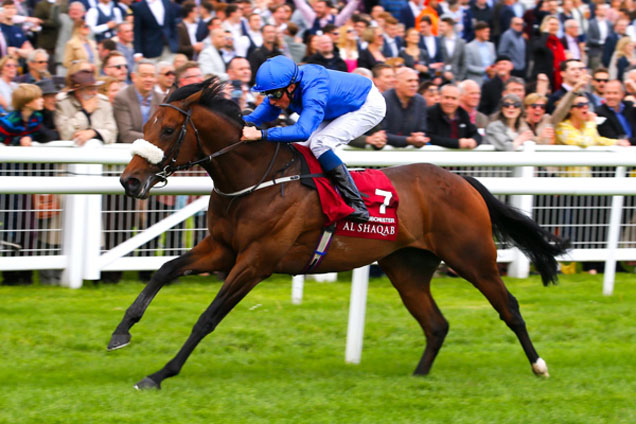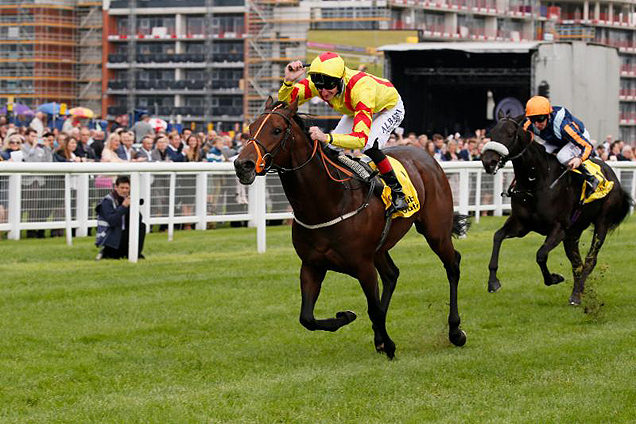3 minute read
Following John Ferguson’s resignation from his role as Chief Executive of Godolphin, Nic Doggett reflects on the performance of the Sheikh Mohammed-owned operation and looks towards the future.
While sons of Pour Moi (Coolmore), Galileo (Coolmore) and Frankel (Juddmonte) fought out the finish of last weekend’s Investec Derby at Epsom – dissected by Simon Rowlands in his Sectional Debrief and by Jamie Lynch in his Ratings Update - the best that Godolphin could muster was the fifth-placed Benbatl, the son of Dubawi clearly more of a stayer than might be expected at first glance from his pedigree. But how did other Darley stallions fare in the race?

Godolphin runner Best Solution is by the Tally Ho Stud’s Kodiac, so it’s down to 10th to find Permian (Teofilo) and 11th for Dubai Thunder (Dubawi). Pealer (last of 18) also warrants a mention as he is by the former Godolphin-owned Campanologist, who died in 2015 at Gestüt Fährhof stud in Germany.

Though this Flat season is still in its formative period, in the 57 Group races in the UK and Ireland to date, Godolphin have had six winners from 45 runners – only the top class Ribchester has done it at the top level (other winners all in Group 3s), and he was a purchase by Godolphin, rather than bred by Darley. The most recent recruit is the high class Sandy Lane winner Harry Angel, who Ferguson, in one of his final acts, described as "one of the most brilliant young horses in training and we're delighted to have purchased him”. He added: "Not only is he a fantastic prospect for all the major Group 1 sprints, being a son of Dark Angel, he also has the added attraction of being a potential stallion.” Dark Angel’s dam Midnight Angel was unraced but went through the sales ring a remarkable seven times – starting off when bought for 50,000 guineas as a yearling by Darley.
John Berry once described the stand-off between Coolmore and Darley as horse racing’s own Cold War, and it’s hard not to feel that the burden of refusing to share blood lines has weighed heavily on the Godolphin operation, allowing the breeding pendulum to swing emphatically in Coolmore’s direction.As the most recent Racehorses annual details… “Aidan O’Brien’s twenty-two Group or Grade 1 victories worldwide in 2016 was one of the achievements of the racing year. But if it was the trainer or his stable who earned most of the plaudits, just as impressive, surely, was the record of the supplier of the raw material for most of that success, Coolmore’s `supersire’ Galileo. Galileo’s sons and daughters provided Ballydoyle with all bar two of those top-level wins which illustrates the importance of an outstanding stallion to an operation that is one of racing’s superpowers. It’s a role which Galileo’s own sire Sadler’s Wells performed successfully and which may in turn be handed on to one of Galileo’s sons, at least if Coolmore’s publicity, which advertises Australia as his `heir apparent’, proves correct.
“A stallion capable of supplying a consistent stream of Group 1 horses is something which that other racing superpower Godolphin has long struggled to produce, leaving them trailing in their rivalry in Group 1 races with Coolmore. The best horse to carry the Godolphin colours, Dubai Millennium, died from grass sickness after just one season at stud, but he did leave behind the high-class Dubawi, a colt whose Group 1 wins included the National Stakes and Irish Two Thousand Guineas, ironically two races that have been dominated by Ballydoyle colts this century. Dubawi started at stud at a fee of £25,000 (Galileo stood at €50,000 in his first season), some way removed from `supersire’ territory and well short of the £100,000 to £120,000 for the services of his ill-fated sire. Dubawi’s fee dropped to a low of £15,000 at one stage, before rocketing in recent seasons as Dubawi has increasingly taken on the mantle of Godolphin’s would-be answer to Galileo.”This year’s Derby was a disappointment for Dubawi, other Darley sires and, arguably two of the three Godolphin runners, but to suggest that the operation’s stallions have not fared well in the Derby in recent seasons would be inaccurate. King’s Best sired 2010 winner Workforce, while sons of Cape Cross won in both 2009 and 2015, firstly Sea the Stars and more recently Golden Horn. The latter now stands at Dalham Hall Stud, Darley’s chief breeding operation in Newmarket, however he is the only recent top-class addition to an ever-growing roster of Darley stallions which appears too numerous and diluted by horses whose achievements on the track quite simply do not come close to the vast majority of Coolmore stallions.
In comparison to eight stallions at Cheveley Park and five stallions at Juddmonte’s Banstead Manor Stud, 14 horses stand at Darley’s Dalham Hall, and another 15 at their Kildangan Stud in Ireland. Some of these are shuttled to other Darley bases around the world, including Japan, Australia and America, all of which also have a large number of resident stallions themselves. Joe Osborne, the current Managing Director of Godolphin in Ireland, has himself been shuttled across to take up the position of Interim Chief Executive of Godolphin’s global operation. Current Dalham residents range from 2007 Derby winner Authorized to Buratino, the latter a smart juvenile who won the Coventry Stakes and stands for just €5,000. Allied to foal share arrangements, various subsidies such as a free nomination to a stallion Darley wants to promote or a contribution to the cost of transporting the mare to the stallion, the picture is one of Darley swiping right much more than left.At the time of writing, 10 Godolphin juveniles have raced this season, eight of whom have won. All are trained by Charlie Appleby, none by Saeed Bin Suroor, who, in a recent interview, explained: "It is a disaster. I can't train them, have no chance to run them. The system is not quite great this year."
Generally speaking, with the exception of New Approach and Lonhro, those sires listed above are all influences for speed. Similar comments apply to Helmet and Sepoy (albeit to a lesser extent) who carried the flag for the antipodean arm of Darley last season, shuttling between northern and southern hemispheres, although neither had big-race wins in their home territory despite both boasting strong strike rates; Criterium International winner Thunder Snow was the highest-rated son of Helmet in Europe, Dabyah the pick of Sepoy’s offspring in the same region. However, the addition of Golden Horn to the Darley roster (first foals this year, shared ownership between Anthony Oppenheimer and Godolphin) should ensure that top-level middle distance races are as much the future targets for those off the Dalham production line as those over a mile or less.Referring to Bin Suroor’s inflammatory comments (which included “Now Sheikh Mohammed makes the decisions at Stanley House, nobody else”) in a statement released after his recent resignation, Ferguson said: “Given the recent articles in the media, it was clear my position was untenable. In times such as these, what matters is the future and my stepping down will allow everyone to draw a line under things and move forward."
Punters would have to draw a line under the figure of -452.88 had they backed all Godolphin horses blind in the UK in the last five seasons, however Ferguson’s recent announcement comes just as the operation is enjoying its most profitable domestic season: +11.75 to date. The success of their young horses – two and three-year-olds – is responsible for that upturn, making the timing of Ferguson’s departure all the more puzzling.The Richard Hannon-trained Barney Roy leads Godolphin’s classic generation, and, like Harry Angel, appears to be part of a strategy to buy very promising horses that also have potential as future stallions. An alternative (and apparently short-lived) approach to this was typified by the purchase of the gelding Scottish, who was bought with an eye to winning big races such as the Melbourne Cup rather than with any eye on future paddock duties. Barney Roy was purchased privately after winning his debut at Haydock in the colours of Jared Sullivan’s bloodstock operation, took a giant leap forward when winning the Greenham at Newbury on his reappearance in April, and did well under the circumstances when a length second to Churchill in the 2000 Guineas at Newmarket last time. Unsuited by the way the race developed and possibly unsuited by track, he remains an exciting prospect and one bound for the St James’s Palace at Royal Ascot in less than two weeks’ time. He may be a strapping son of the Coolmore sire Excelebration, however Excelebration is in turn the son of Darley stallion Exceed and Excel.
Hannon explained: "It was a big thing for us to have Godolphin involvement in the yard and John [Ferguson] was responsible for engineering that. Barney Roy, Night of Thunder and Toormore have all done well for us in Godolphin colours. When we had the right horses John was always keen to take them, but also to leave them in the yard. He's been a big help to us."Another Godolphin flag bearer, albeit a more mature one, is Ribchester. Owned by trucker-cum-breeder David Armstrong originally (who also bred current Cheveley Park stallions Garswood and Mayson), Ribchester was acquired by Godolphin after finishing second in the Gimcrack at York, immediately winning the Mill Reef at Newbury and has since added three further wins – most notably last year’s Jacques le Marois at Deauville and last month’s Lockinge back at Newbury.
He’s arguably a more crucial cog in the wheel than Barney Roy, being a son of Iffraaj, a horse originally owned by Sheikh Ahmed bin Saeed Al Maktoum and trained by Michael Jarvis, but then bought by his nephew – Sheikh Mohammed [bin Rashid Al Maktoum]. After winning heritage handicaps such as the Victoria Cup and Wokingham, Iffraaj won the Park Stakes (twice) and the Lennox Stakes (once), though never a Group 1 – he came agonisingly close to winning the 2006 July Stakes but lost out by a head to Les Arcs. When Barney Roy hits the paddocks he will be a (boys in) blue blood Darley stallion, and, one supposes, a focal point for the operation.The second-highest rated horse in Europe is Jack Hobbs, another high-profile acquisition. A son of Halling, Jack Hobbs won his first two starts for connections, including Rachel Hood (Mrs John Gosden), and was officially bought by Godolphin after finishing second to Golden Horn in the 2015 Dante at York. As has been the recent methodology since the purchase of the currently winless first-season sire Dawn Approach in 2012, he was left in the care of John Gosden and justified that decision with a gallant second to the same rival in the Derby at Epsom, followed by an emphatic win in an average renewal of the Irish Derby the following month. Since then he has been third in two renewals of the Champion Stakes at Ascot, before producing a clear career-best when winning the Sheema Classic in first-time blinkers at Meydan in March. Looking ahead to Royal Ascot, connections must now weigh up whether to run him under a penalty in the Hardwicke Stakes over his ideal trip or off level weights in the Prince of Wales’s Stakes over a distance short of his best.
Royal Ascot will see more focus on Godolphin than usual, the scrutiny already close enough as they bid for a first Group 1 winner at the royal meeting since Dawn Approach’s success in the 2013 St James’s Palace. While the short-term gains of a Ribchester win in the Queen Anne, a Profitable success in the King’s Stand, or a Harry Angel victory in the Commonwealth Cup would be great for Godolphin, the true measure of success for Godolphin and Darley will come when their leading stallions can match the achievements of Sadler’s Wells, Galileo, Montjeu et al on the biggest of stages. It seems likely that a lot will rest on the shoulders of Golden Horn.





